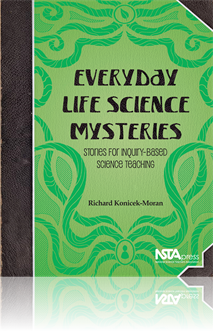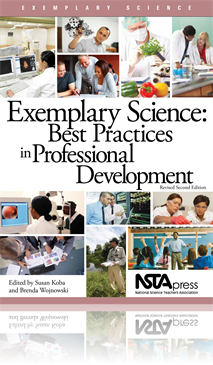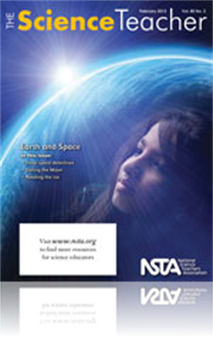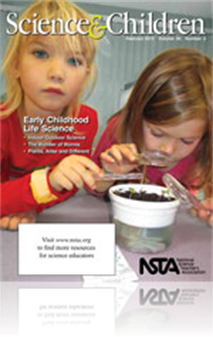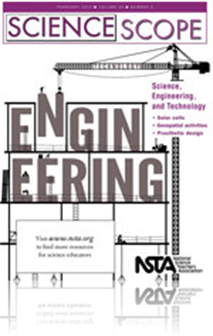All Resources
Book Chapter
Children and adults alike are prone to believe that if a little of something is good, more is better. In the case of this story, your students will probably believe that if fertilizer is good for growing plants, it must be good for germinating seeds....
Book Chapter
Water makes up a very high percentage of all living things. This story is aimed at providing children with the opportunity to measure the surprising amount of water found in fruit. It also provides an opportunity for the teacher to emphasize the impo...
Book Chapter
What happens when seeds are soaked in water, you may find that your students cannot perceive of seeds absorbing so much water, for they may equate the seeds with how a sponge soaks up water. The story in this chapter offers students an opportunity to...
Book Chapter
Students are usually aware that seed plants have adapted to overcrowding by developing mechanisms that disperse their seeds to other locations. In this chapter, the story explores one of the important characteristics of plant evolution, the wide dist...
Book Chapter
Students may well have the usual “bigger is better” conception about comparing different items. Pumpkins are the perfect object to help engage students in investigative science and answer most of their questions by direct observation....
Book Chapter
Children may not be aware of what is exactly happening when they have their pulse taken by a doctor or nurse or even why it is important. The story in this chapter is aimed at helping children discover what kinds of activities change their heart rate...
Book Chapter
Most students are totally unaware of the amount of sugar in bubble gum and don’t know that they are literally eating sugar in huge amounts. In this chapter, the author is concerned with finding out what happens to the weight of gum when it is chewe...
Book Chapter
Just what kinds of characteristics do living things receive from their parents and what kinds of traits do they not? What makes the offspring of any animal or plant have the basic characteristics of the parents? There happen to be a great number of h...
Book Chapter
Hardly a day goes by without something arriving by e-mail or being posted on the internet that just doesn’t sound true. The students in this story are depicted as having alert skepticism about things that don’t actually add up in their minds and ...
Book Chapter
Students may have the impression that all kinds of reaction time responses can be improved through practice. They may believe also that every kind of stimulus produces the same kind of reaction time. The story, in the chapter, provides the opportun...
Book Chapter
Segmented worms are considered “yucky” by a great many people, yet they are members of a large animal group that populates the entire world and provides a great service to our planet. This story should stimulate students to want to know more abou...
Book Chapter
This story is true, although Maria and Enrique are fictional characters. A barred owl does live in the rafter of the chickee at Shark Valley and does drop owl pellets from its nest almost daily. The purpose of this story is twofold: (1) to learn more...
Book Chapter
The story, in this chapter, is meant to show students the importance of leavening agents in making baked goods. Yeast, a living organism (a fungus), is necessary for baking risen yeast breads. This fungus can be ineffective if it is not healthy. The ...
Book Chapter
The mystery here has a lot to do with the life cycle of the insect in the cereal and what the various stages were that Emma found in the box. However, it is important that children get to know more about the most populous animals on our planet. It is...
Book Chapter
Lichens are everywhere, yet most people fail to notice them because they are so familiar. The story in this chapter was written to help persuade teachers to acquaint their students with these unique forms of life. Many biology teachers tend to gloss ...
eBook
Exemplary Science: Best Practices in Professional Development, Revised 2nd Edition (e-book)
“This book will help the reader to design and evaluate varying professional development options, thereby making better and more efficient use of limited professional development dollars.” —The editors of Exemplary Science: Best Practices in P...
Book Chapter
Assessing and Addressing Student Science Ideas
Our students are not blank slates. They come to school with a wide range of experiences that have shaped their science understandings—reading books, watching TV, and playing video games. From many years of research about student science ideas, it i...
eBook
Perspectives: Research and Tips to Support Science Education, K–6 (e-book)
“This book provides research-based justification for the types of inquiry-based science practices we want K–6 teachers to be doing. It answers the questions ‘Why does science need to be in an elementary classroom?’ and ‘What are the most ef...
Journal Article
Reading the Ice: Using Remote Sensing to Analyze Radar Data
This article describes two lessons, based on the 5E model, that help students practice scientific data collection and introduce them to remote sensing....
Journal Article
Science 2.0: A Flipped Classroom in Action
This column shares web tools that support learning. This month’s issue discusses the flipped classroom approach....
Journal Article
Formative Assessment Probes: Labeling Versus Explaining
This column focuses on promoting learning through assessment. This month’s issue discusses the life cycle of a butterfly....
Journal Article
Hand Drawn: Lessons on Neuromuscular Control and Prosthetic-Hand Design
Design prosthetic hands specifically tailored for students' favorite activities....
Journal Article
Methods and Strategies: I Wonder...
This column provides ideas and techniques to enhance your science teaching. This month’s issue discusses how "I Wonder" boards serve as a springboard for scientific investigations....
Journal Article
The Isle of Navitas: Planning for Energy Use With Web GIS
Engage in authentic scientific practices using geospatial technologies to plot an island's energy resources....
Journal Article
Integrating Science and Engineering Practices in an Inquiry-Based Lesson on Wind-Powered Cars
Construct a wind-powered car to reinforce science content and practices....
Journal Article
The <i>Next Generation Science Standards</i> and the Life Sciences
Using the life sciences, this article first reviews essential features of the NRC Framework for K–12 Science Education that provided a foundation for the new standards. Second, the article describes the important features of life science standards ...
Journal Article
A kindergarten science curriculum develops life science investigations in and around school. ...
Journal Article
Making Connections Through Conversation
First graders explore the circle of life through observations of animals in their habitats....
Journal Article
Tried and True: Rock 'n' Roll: An Inquiry Investigation of Stone-Based Construction Materials
This column provides classic demonstrations and experiments with a new twist. This month’s issue discusses an inquiry-based activity that gets students excited about a unit on rocks....
Journal Article
Teacher's Toolkit: Troubleshooting: A Bridge That Connects Engineering Design and Scientific Inquiry
This column provides how-to strategies and practical advice for the science teacher. This month’s issue discusses how to troubleshoot during the design process....
Journal Article
Compost: The Rot Thing for Our Earth
A yearlong classroom project encourages scientific practices and knowledge about ecology....



